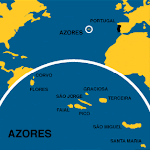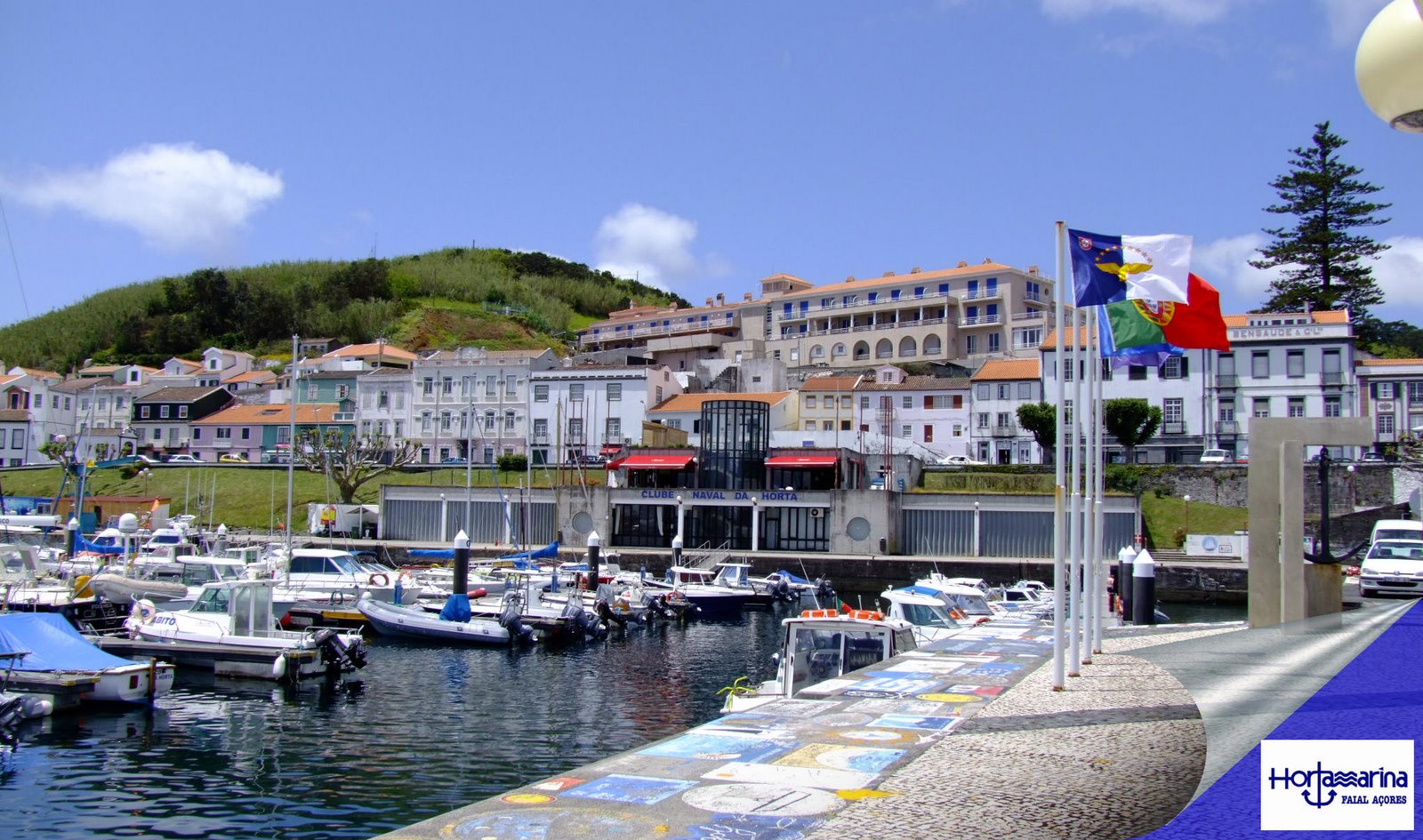In The Azores Onwards To Faial And Pico
"Peter Café Sport is the heart of Faial: the meeting point of yachters crossing the Atlantic, where they can swap their yachting stories and show their yachting tans. While in the harbour there is an obvious hierarchy of size and fanciness among the yachts, here the retired couple courageously sailing their 18-footer can schmooze on an equal standing with the spoiled scion on the 3-masted ship in search of life’s meaning with his boat full of hanger-ons. Around Peters lies Horta, a miniature city on the miniature island of Faial, Azores, Portugal.
After spending 3 months on the island of São Miguel I thought I had the Azores pretty much down pat. Agricultural, isolated, beautiful nature. I could not imagine that the island of Faial could be so different.
We arrived in Faial in early April and immediately made a startling discovery: the weather in Horta city is much sunnier than on the rest of the island – not an obvious fact considering that it’s only 15 kilometers across. As it is, the bulk of Pico and of Faial’s own “caldeira” (extinct volcano) seems to attract the clouds, so if you’re up on the hills chances are that you’ll be caught in a low cloud or else standing right underneath it. Tip: if you want to spend some time here, try and stay in Horta City.
I am not a boater so I can only imagine what it must feel like to arrive in Horta after one or two weeks in cramped quarters on a sailboat crossing the Atlantic.
Faial is part of the Central Group of the Azorean islands, the other two being Sao Jorge and Pico. Pico is the highest mountain in the whole territory of Portugal, a nearly perfect cone jutting 2 kilometers high out of the Atlantic at an inclination of almost 45 degrees. It is often capped by snow and almost constantly graced by a mantle of clouds. The view from the deck of the approaching boat must be very impressive. And once the boat has slid into the narrow strait that separates the islands, the white city of Horta appears, with its beautifully painted houses that are witness to the two periods of greatest prosperity in its history.
Because of its natural port, Horta was already an important mid-Atlantic stop soon after it was founded by a Flemish merchant. Its geographic position made it a fortune again in the late 1800s, when it became a joining station for the first transatlantic telegraph cables. As a result, the city is graced with beautiful merchant houses whose unique construction blends Portuguese and Northern European styles, as well as some stunning Art Deco buildings.
If you stand on the harbor in Horta and look towards the shore, you can see the Monte do Guia on your left, the slopes of the main volcano in front of you, the red windmills on the hills of Conceição, and the Espalamaca viewpoint on your right, complete with a giant concrete Holy Cross. Behind you, majestic Pico.
The rest of the island is a bit of a necessary, utilitarian bolster to this magnificent stage, supplying it with some fresh produce and fields for cows. You get the feeling that the rest of Faial is only there because an island also needs "another” side in order to stand up. But more importantly, northern and eastern Faial do not have any useful harbors: they are deprived of the view of Pico, not sheltered from the ocean, and in general feel like the unspectacular back of a house with a grand façade.
The exception to this is perhaps the frightening site of Capelinhos, where a volcano erupted in 1957, burying a village and creating a whole new two square kilometers of island. It is an eerie expanse of black sand, as yet unconquered by plants, as though the world must have been billions of years ago. In fact, it is impossible to judge its size just by looking at it, as there isn’t even one shrub to act as reference, and its curved surface tricks the eye before swirling into the ocean.
Sitting in the sophisticated cafés of Horta, however, the thought of the islands’ stormy geological history could not be further from our minds. I have called Horta a “city” above, and not without reason, although it has just 10,000 inhabitants, it behaves like a prosperous and sophisticated city, with beautiful buildings, free city-wide Wi-Fi access, bus lines, a national-chain supermarket, fancy clothes stores and a couple of fine hotels.
Somehow, Horta reminds me of my native Florence, Italy, splendidly isolated, always aware of how it looks in the eyes of its visitors – although the relief of setting foot ashore might also have something to do with Horta’s charm. The island’s landscape – if compared to the other islands that I visited – also has the gentler beauty of Tuscany, with rounder shapes and more muted colors. Or maybe it’s the dapper young intellectuals who attend the screenings of the local Cineclub. Maybe it’s the quality and variety of the local buns, a must with your morning’s galão (what’s known as latte in the US). Maybe it’s in the sophisticated air of its teenagers as they elegantly pace out of their school, their clothes quite obviously influenced by the visitors from the sea.
It’s funny that an island’s focal point is another island, but this is exactly what happens in Faial. Pico is always there, attracting your eyes as ineluctably as it attracts every cloud in the center of the Atlantic ocean. And when you cross over the straits - 3 boats a day (more in the Summer) make the 15-minute crossing from Horta, Faial to Madalena, Pico - you feel you've entered into another world.
Pico looks like a gaint heap of lava that hasn’t even finished cooling (and indeed it’s a geological baby, only 300,000 years old). The walled vineyards of its southeastern slopes make up an unique landscape which has been declared a World Heritage site by UNESCO in 2002 .
When compared to the domesticated and urbanized small island of Faial, Pico is vast, rugged, and less populated, with the same number of inhabitants (15,000) in over 3 times the area. Most of its surface, however, is occupied by the slopes of its eponymous mountain, covered in heather and moss and almost invariably encircled by clouds.
Many residents of Horta have summer houses on Pico, using them either to go tend to their vineyards or just to relax in the “country”.
A lot of people like Faial, and a lot of foreign nationals have made it their home (mostly British, and less Germans than in São Miguel, with a smattering of French). The few people I talked to about this invariably told tales of falling in love with the island during a stopover on their yacht. However it is Pico that excites the greatest passions: from the translator who decided to move here (until he met his beloved and his plans changed), to the cranky American expat who after my previous article threatened me if I dared to suggest that Pico was a worthwhile expatriate destination. Although I have only visited it on day trips, the people from Pico seem indeed to have a wilder side than the Faialenses – certainly an inheritance from their glory days of whaling.
Of course in Pico you’re on a true outback – no small city there, just some overgrown villages. If you’re considering an extended visit or even a long stay, be prepared for a lack of urban comforts.
We left Faial after only one and a half months of the three months of our planned stay. Bored with the island life? Disappointed with the weather? Actually, the reason we left was – more mundanely – that we were not very happy with the house we had rented. We left heaving a sigh of relief and looking forward to the sophistication and… urbanity of rural Ireland, and to our cottage in County Wexford (of which I will write about in another article). Yet already after a week I feel the nostalgia that seems to be common to all of us who have experienced the Azores. Will we go back and live there? Probably not, there are too many inconveniences that we are not prepared to compromise on. But these islands in the middle of nowhere have dug a permanent place in my heart."
by Giovanni Giusti, June 2005



























3 comentários:
Hello from Switzerland!Thanks for your comment.
I look the look of your blog. However, if you are going to leave your link on someone else's comments, I think it's a good idea to say more than just hello. Otherwise it looks as if the only reason you have left a comment is to get traffic and links.
Regards from Qatar :)
The idea is to promote Azores, and the island of Faial, it´s a beautiful place.
If you return, leave your link.
We need friends in all places.
Thanks for the visit.
Enviar um comentário